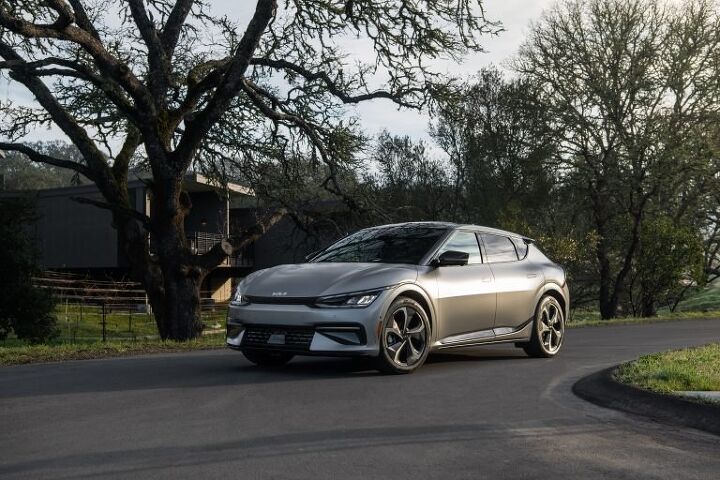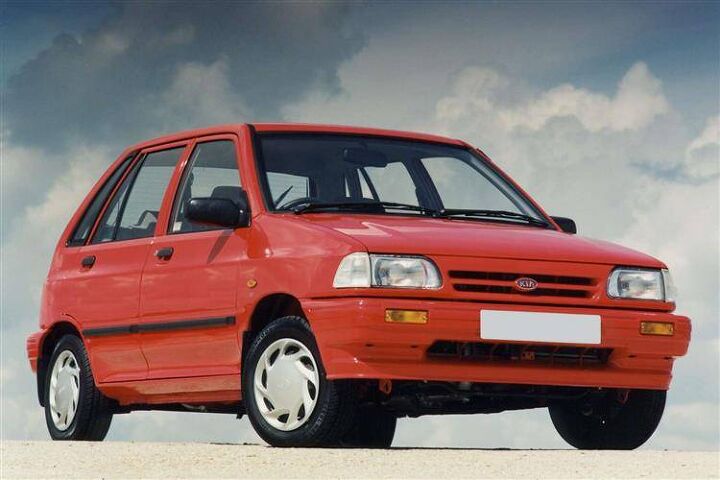#kia
Opinion: The Overstyling Of Hyundai/Kia Vehicles May Be Coming To A Head
I’ve seen the new Kia Sportage in person. I’ve also seen the new Hyundai Tucson up close. Both show the companies’ latest take in a series of outrageous designs that are meant to win over consumers.
Kia Wins Wards 'Best Interior' Award For EV6
Kia’s continual improvements are getting noticed by Wards Auto.
2022 Kia Forte GT Review – Words Matter
I’ll grant that I’m not a university-trained linguist, but I will forever cringe when I encounter egregious misapplications of the English language. Examples include the otherwise-excellent Alanis Morissette applying the term “ironic” to simple coincidence, and the ever-present misuse of “literally” by my kids when describing a figurative.
In the realm with which I’m more familiar, we can consider the heinous mislabeling of sundry sedans and crossovers as “coupes” due to their sloping rooflines. Another is the haphazard use of the “GT” badge, a violation that most automakers have made over the decades. GT, of course, originally implied Grand Touring – and has been since claimed by various racing series to denote race cars that have been based upon street cars.
I’m not certain which definition was in mind when the 2022 Kia Forte GT was in development.
Rare Rides Icons: The History of Kia's Larger and Full-size Sedans (Part VII)
We return to Kia’s midsize-or-larger sedan history today in the latter portion of the 2000s. In our last entry, we learned about the Optima, which arrived as Kia’s first midsize developed under Hyundai’s majority ownership. Sensibly the Optima was a light rework of Hyundai’s Sonata, and the two shared almost everything (including very poor crash safety ratings).
On the more executive full-size side of the lineup, Kia’s Opirus was the first large car developed under Hyundai ownership. It shared a platform with the Grandeur (XG350 to you). While the Opirus saw okay sales in most markets, it failed in North America where it was sold as the Amanti. Very few North Americans wanted a $39,600 (adjusted) Kia, no matter how many luxury styling touches it borrowed from other brands. And so the Amanti was canceled after 2009 locally (2012 elsewhere). By that time its replacement was already on sale. Meet K7.
Rare Rides Icons: The History of Kia's Larger and Full-size Sedans (Part VI)
We return to the story of Kia’s midsize and larger sedans today, around the point when Kia found itself under the watchful eye of Hyundai. The larger South Korean company purchased a controlling stake in its competition in 1998, which meant big changes to Kia’s product almost immediately after.
The union led to the first full-size luxury sedan Kia developed from the ground up, the Opirus (Amanti to you). It turned out the Amanti was the derivative and rather ugly sedan few in North America desired, though it fared a bit better elsewhere. But by the time the Amanti arrived, Kia was already selling a new midsize that North Americans did want. Let’s talk Optima.
2022 Kia Sorento Hybrid Review - Three Rows*, Thirty-Seven MPG
As I and others on these virtual pages have noted time and again, electric vehicles are Not Quite Ready For Primetime in much of the country for most people. We don’t have a charging infrastructure ready to support the types of driving most do on a regular basis, nor do we have the collective will to change our driving habits to suit an all-electric lifestyle.
And yet gasoline prices continue to climb. I spotted regular unleaded at $4.99 per gallon this weekend – if that number seems quaintly laughable by the time this hits the presses, my apologies. I’m taking a hard look at the driving my family needs to do, and strongly reconsidering what best fits my driveway and my budget.
Some sort of electrification is coming sooner rather than later to each of us if we aren’t there already. Two-plus decades of hybrids have proven the reliabilities of the technologies involved. A roomy family-sized vehicle, much like this 2022 Kia Sorento Hybrid, should take the sting out of what had once been a realm reserved for Spartan subcompacts.
Rare Rides Icons: The Ford Festiva, a Subcompact and Worldwide Kia by Mazda (Part IV)
We reached a conclusion to the first Ford Festiva (or Kia Pride, Mazda 121, SAIPA, etc.) in our last installment, which saw the little hatchback finalize its Ford duties in 1993 and its Kia responsibilities in 2000. And while it continues life today as a Wallyscar in Tunisia, our coverage here moves on to Ford’s not-so-anticipated follow-up entry to Festiva, another Festiva! It’s an Aspire to you.
Kia Rumored to End Stinger and K5 Production, Brand Says Nah
Following reports that the Hyundai Sonata may not be long for this world, there have been rumbling that the fate of the Kia Stinger and K5 sedan may also be in jeopardy.
The reasoning is obvious. After years of crossovers seeing an increased share of the global market, automakers have been dumping sedans so they can sell products that come with higher margins. A sizable percentage of the population has also been sold on the theory that higher-riding vehicles are automatically safer than their road-hugging counterparts. While that is endlessly debatable between models, there are aspects of crossovers that make real sense for the modern era. Storage capacity is typically better than what you’d find on a similarly sized sedan and the lengthened suspension travel can help the vehicle absorb the impact of pothole-laden streets that seem to be cropping up everywhere.
Rare Rides Icons: The History of Kia's Larger and Full-size Sedans (Part V)
In our last installment of Kia’s larger sedan history, we covered the midsize Credos. The Credos was an important first for Kia, as the first midsize the company produced where it had a bit of leeway with the design. Ultimately, the Credos hid its Mazda 626 bones decently well and did a good impersonation of a late Nineties Ford Contour after a refresh.
But just as Kia settled into Mazda platforms and designing their own sedans, the goalposts were moved courtesy of the 1997 Asian financial crisis. Kia was left without much money, and few options. We pick up there.
Rare Rides Icons: The Ford Festiva, a Subcompact and Worldwide Kia by Mazda (Part III)
We return to the Ford Festiva once again today, as the subcompact Mazda-designed hatchback stormed North American shores. It did so wearing a Ford badge and a South Korean VIN, courtesy of a Kia factory. But North America wasn’t the only place it landed.
As we learned last time, the Festiva was built in several different countries and assumed many identities over an extensive history. The Festiva still has not reached the end of its life, but we’ll cover that in a separate article. We pick up today in North America, circa 1987.
Rare Rides Icons: The History of Kia's Larger and Full-size Sedans (Part IV)
We return to our coverage of Kia sedans today and discuss a midsize from just prior to the flagship Enterprise we discussed last time. Kia offered the first midsize car to bear its branding in 1987 when it introduced the new Concord. Concord was essentially a broughamed, front-rear clip swap take on the GC platform Mazda 626. Mazda discontinued the GC 626 that year and immediately sold the platform and tooling to Kia. A couple of years later, the Concord spawned a lesser sibling called the Capital. Capital looked very similar to the Concord but sold to a more economically-minded customer with its much lower level of equipment and low-powered engines.
When the Capital finished up its run in 1997, it was replaced by a compact car Kia had on sale for a few years already: The Sephia. Sephia wouldn’t do for Concord-level customers though, and upon the sedan’s discontinuation in 1995 they were directed to an all-new Kia. The company was ready with its new midsize to bookend the Concord, and it went on sale the same year. Though the new car was again on a donated platform, it was the first time Kia had some leeway to design a midsize of their own. It’s time to discuss Credos.
Rare Rides Icons: The Ford Festiva, a Subcompact and Worldwide Kia by Mazda (Part II)
We return to our Rare Rides Icons coverage of the Ford Festiva today. An important world vehicle for the likes of Ford, Mazda, Kia (and eventually many others), the Festiva arrived at a time when rear-drive subcompacts were being replaced by much more efficient models that were front-drive. And the Mazda-designed Festiva was certainly more efficient and more front-drive than the Fiesta it replaced.
Lightning Strikes the TTAC Podcast
The TTAC podcast is back! In our fourth episode, we talk Ford Lightning, Kia Sportage, Formula One in Miami, and the best cars from 2007.
Rare Rides Icons: The History of Kia's Larger and Full-size Sedans (Part III)
We’ve reached the end of the Nineties in Kia’s midsize-or-more sedan story. It was a time of modernization across Kia’s portfolio, and 1998 and 1999 were years of expansion in particular: Kia introduced an impressive nine all-new models across those two years.
For its larger sedan lineup, the dated Potentia (a rework of the Eighties Mazda Luce) continued on in its popularity in the South Korean market. Potentia was updated from its original 1992 looks for 1998. However, that same year Kia introduced a new large luxury sedan to its lineup. The company once again relied on friendly product partner Mazda. Let’s talk about Enterprise.
Report: Hyundai May Choose Georgia for EV Plant
Hyundai Motor Group has been considering where to establish its planned EV manufacturing hub for the United States for roughly a year now and is reportedly zeroing in on the State of Georgia as a final destination. It’s even said to have conducted some preliminary meetings with local leaders about the possibility of breaking ground in an area that could be strategically aligned with its existing facilities – namely Montgomery’s Hyundai Motor Manufacturing Alabama (HMMA) and West Point’s Kia Motors Manufacturing Georgia (KMMG).






























Recent Comments